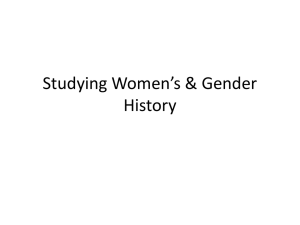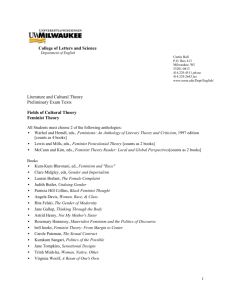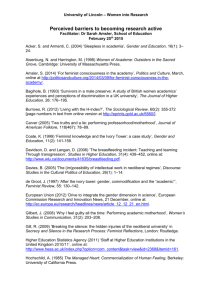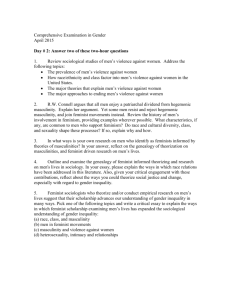Writing Women*s History
advertisement
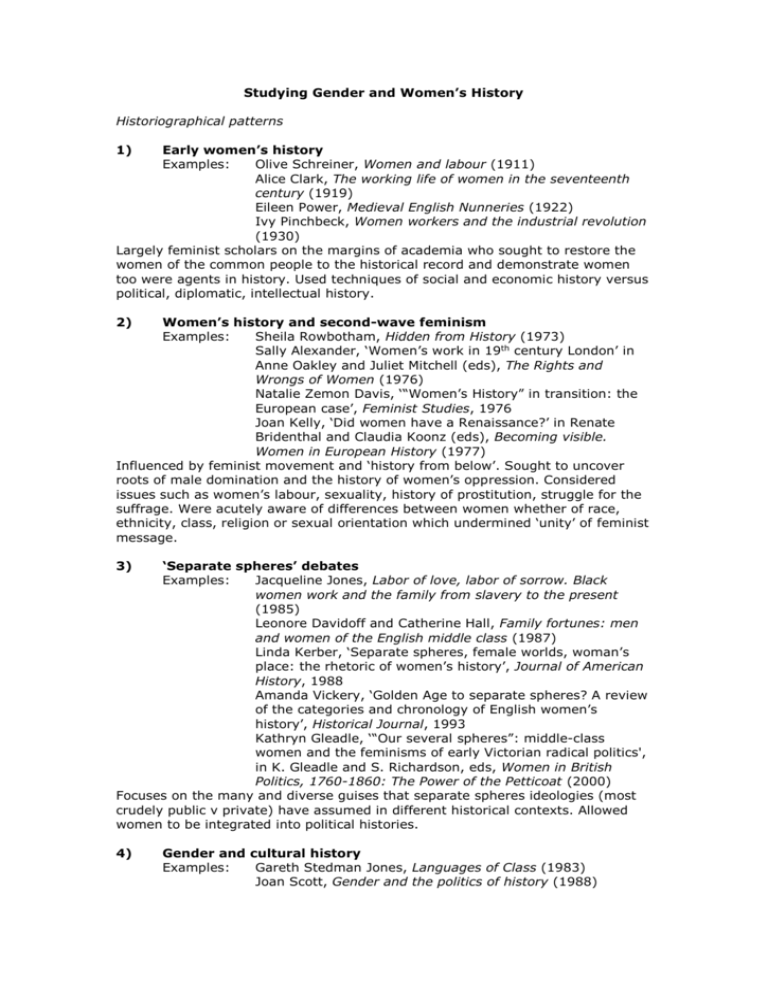
Studying Gender and Women’s History Historiographical patterns 1) Early women’s history Examples: Olive Schreiner, Women and labour (1911) Alice Clark, The working life of women in the seventeenth century (1919) Eileen Power, Medieval English Nunneries (1922) Ivy Pinchbeck, Women workers and the industrial revolution (1930) Largely feminist scholars on the margins of academia who sought to restore the women of the common people to the historical record and demonstrate women too were agents in history. Used techniques of social and economic history versus political, diplomatic, intellectual history. 2) Women’s history and second-wave feminism Examples: Sheila Rowbotham, Hidden from History (1973) Sally Alexander, ‘Women’s work in 19th century London’ in Anne Oakley and Juliet Mitchell (eds), The Rights and Wrongs of Women (1976) Natalie Zemon Davis, ‘“Women’s History” in transition: the European case’, Feminist Studies, 1976 Joan Kelly, ‘Did women have a Renaissance?’ in Renate Bridenthal and Claudia Koonz (eds), Becoming visible. Women in European History (1977) Influenced by feminist movement and ‘history from below’. Sought to uncover roots of male domination and the history of women’s oppression. Considered issues such as women’s labour, sexuality, history of prostitution, struggle for the suffrage. Were acutely aware of differences between women whether of race, ethnicity, class, religion or sexual orientation which undermined ‘unity’ of feminist message. 3) ‘Separate spheres’ debates Examples: Jacqueline Jones, Labor of love, labor of sorrow. Black women work and the family from slavery to the present (1985) Leonore Davidoff and Catherine Hall, Family fortunes: men and women of the English middle class (1987) Linda Kerber, ‘Separate spheres, female worlds, woman’s place: the rhetoric of women’s history’, Journal of American History, 1988 Amanda Vickery, ‘Golden Age to separate spheres? A review of the categories and chronology of English women’s history’, Historical Journal, 1993 Kathryn Gleadle, ‘“Our several spheres”: middle-class women and the feminisms of early Victorian radical politics', in K. Gleadle and S. Richardson, eds, Women in British Politics, 1760-1860: The Power of the Petticoat (2000) Focuses on the many and diverse guises that separate spheres ideologies (most crudely public v private) have assumed in different historical contexts. Allowed women to be integrated into political histories. 4) Gender and cultural history Examples: Gareth Stedman Jones, Languages of Class (1983) Joan Scott, Gender and the politics of history (1988) Denise Riley, Am I that Name? Feminism and the category of women in history (1988) Anna Clark, The struggle for the breeches (1995) Puts men back into the picture and is associated with the rise of histories of masculinity in the 1980s and with studying issues of power relationships between men and women. Concerned particularly with the construction of masculine and feminine identities across the social spectrum. 5) Gender and postcolonialism Examples: Edward Said, Orientalism (1978) Mrinalini Sinha, Colonial masculinity (1997) Frances Gouda and Julia Clancy-Smith (eds), Domesticating the Empire. Race, gender and family life in French and Dutch colonialism (1998) Nancy Hunt, Gendered Colonialisms (1998) Chandra Mohanty, Feminism without borders (2003) Colonial/postcolonial studies rose out of the broader social history tradition via critiques that arose from within – particularly feminist and nationalist critiques of the primacy of class as a category. Feminist scholars of the developing world have attacked western feminists for refusing to explore the different meanings that being a woman may have in various class, racial, ethnic or religious contexts thus maintaining First World/Third World connections.
